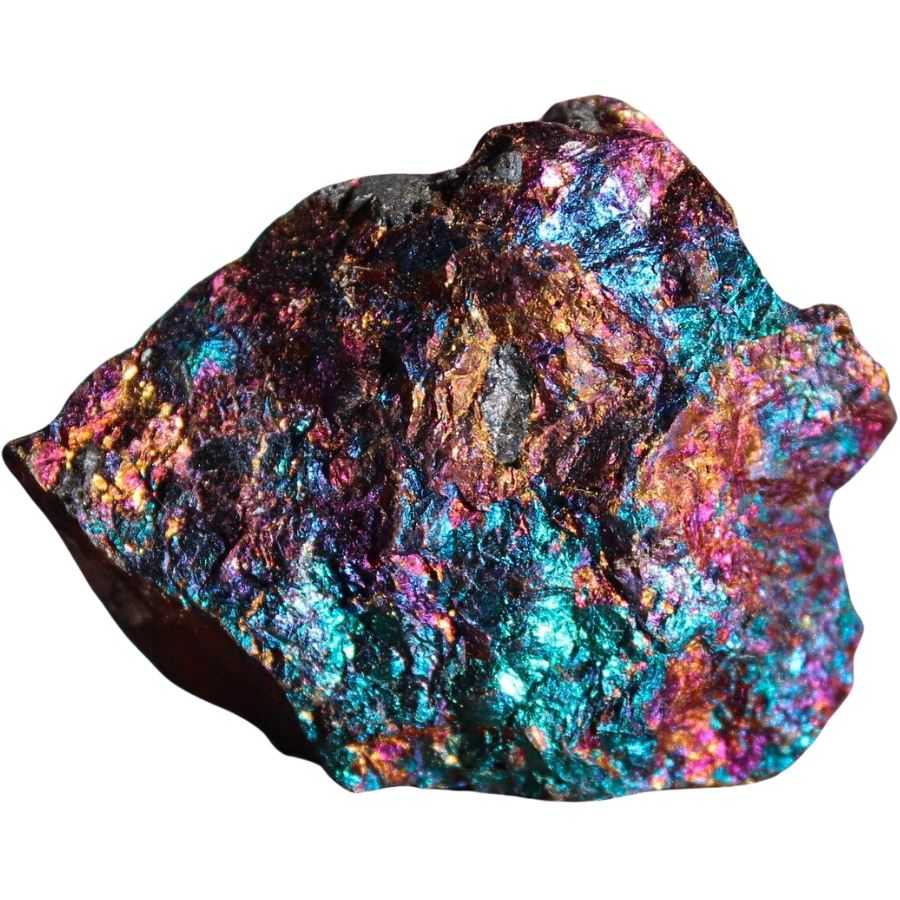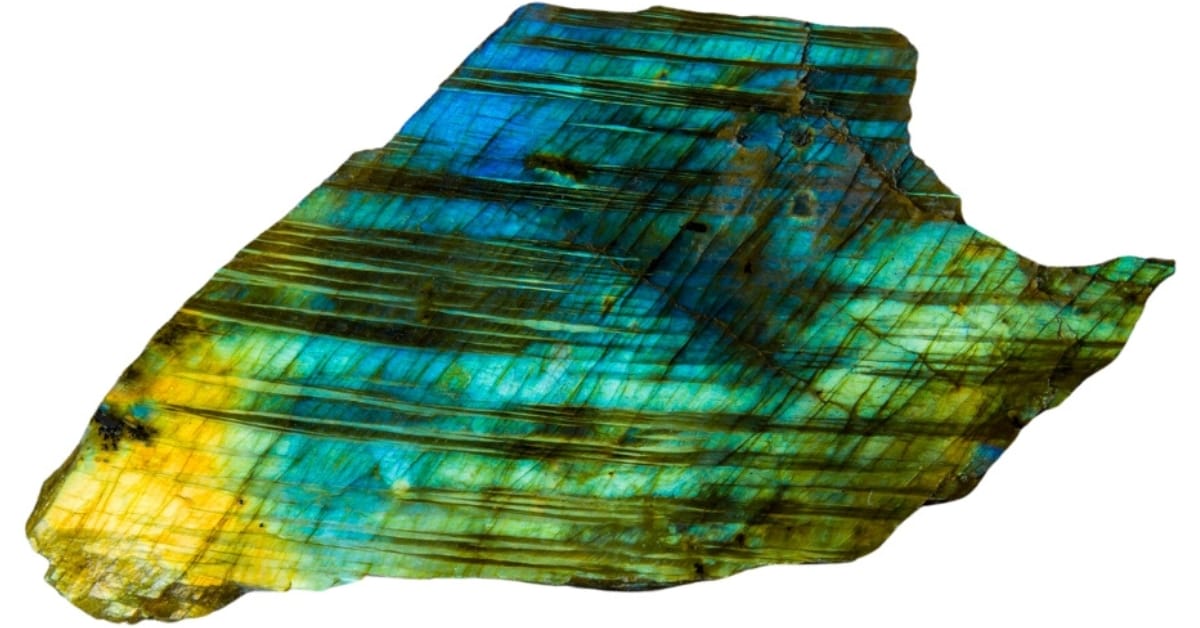Have you ever seen a gemstone that sparkles with all the colors of the rainbow? That’s iridescence for you! You might see blues, greens, pinks, and purples, all shifting and changing as you move the gemstone around.
This happens because of how their tiny structures inside bounce light around in special ways. In this article, we’ll get to know the most stunning iridescent gemstones you need to see. Let’s get movin’!
Iridescent Gemstones You Need To See
Iridescent gemstones shimmer with all the colors you can imagine. When light hits them, they glow with a rainbow of colors that seem to dance and change right before your eyes. Below are some of the most stunning ones out there:
Opal

Opal is a stunning gemstone that’s like a rainbow trapped in a rock. It shines with a play of color, flashing all sorts of shades that can include blues, greens, reds, and more.
It forms from silica-rich water that seeps into cracks and spaces underground, hardening over time. What makes it so special is its rare and dazzling color show.
This unique feature, along with their natural beauty, is a great influence on the value of opal and why it’s sought after.
Labradorite

Labradorite flashes with colors like the northern lights. It’s mostly gray, but when you move it around, you’ll see stunning blues, greens, and sometimes even oranges and pinks.
This magical effect is called labradorescence, and it’s all thanks to the way the stone is made. Deep beneath the surface, minerals slowly cool and arrange in layers, creating this iridescent display.
People love this gem for the way it lights up with a spectrum of colors. The price of labradorite can vary, but its unique beauty makes it a valuable find.
Moonstone

Moonstone is like a piece of the night sky that you can hold in your hand. It’s usually white or pale, but when you move it around, you’ll see a magical glow that shifts and changes.
This glow, called adularescence, is a kind of iridescence that makes it so special. It forms from two types of feldspar mixing, cooling slowly, and then separating into thin layers.
There are different types of moonstones, each one giving off a dreamy look. Truly, it’s a gem that captures the mysterious and enchanting beauty of moonlight.
Ammolite

Ammolite is like a rainbow frozen in time. It comes from the fossilized shells of ancient sea creatures called ammonites.
What’s awesome about ammolite is its iridescence. It shines with many colors, especially reds, greens, and blues. This special effect happens because of the way minerals turned into gemstones over millions of years.
Ammolite is pretty rare, which makes it really special. People value it for its unique beauty and the way it catches the eye, making it a standout choice for jewelry.
Sunstone

Sunstone sparkles like sunlight captured in stone, making it a real eye-catcher. It’s usually orange or reddish, but what sets it apart is the glittery effect caused by tiny plates of minerals inside.
This shimmer, often called aventurescence, looks like the sun shining on water. This gem forms from cooling lava, where these mineral plates align and give it that special sparkle.
People love sunstone for its bright, cheerful appearance and the way it lights up with a warm glow.
Fire Agate

Fire agate is brownish on the outside, but when you look closer, you see an amazing play of colors. It has layers of silica and iron oxide that bend light, creating a fiery iridescence.
With colors of reds, oranges, and greens, this gem seems to glow from within. It forms when hot water filled with silica and iron oxide flows into cracks and spaces in rocks, cooling down and creating this cool effect.
The value of fire agate comes from its unique, dazzling appearance, making it a standout gem that catches everyone’s eye.
Pearl

Pearls are little treasures from the sea, shining with a soft, glowing light. In fact, it’s easy to identify pearls; just look for its gentle luster and smooth feel.
They’re unique because they’re made by oysters and other mollusks when a tiny bit of sand or something else gets inside.
The oyster covers it with layers of nacre, a shiny substance that makes it look so pretty. This process can take years! Pearls can be round or odd-shaped and have a beautiful iridescence.
Goethite

Goethite is usually brown or yellowish-brown and can have a sort of rusty look. Sometimes, it shows off an iridescent surface, shimmering with rainbow colors.
This happens when it forms in areas with lots of water and oxygen, where iron minerals change over time. It’s distinct because it can form these awesome, spear-shaped crystals or just be kind of earthy and chunky.
People value goethite for its unique look and the way it can tell us about the environments where it formed.
Bismuth

Bismuth usually has a silvery color, but when it’s exposed to air, it forms an amazing rainbow of colors on the surface. This iridescence makes bismuth really stand out.
When it cools from its melted form, bismuth creates incredible geometric shapes, like stairs or spirals. It’s pretty rare to find it in nature, so most of what we see is made by people.
The price of bismuth can vary, but it’s valued for its unique shapes and stunning rainbow colors.
Bornite

Bornite is often called “peacock ore” because of its amazing colors. When it’s fresh and unweathered, it looks kind of copper-red or bronze. But when it’s exposed to air, it starts to tarnish and shows off a brilliant mix of blues, purples, and greens.
This iridescence makes it look like a peacock’s feathers! It forms from copper and iron combined with sulfur in underground environments.
Bornite is valued for its striking colors and shiny appearance. It catches your eye and makes you appreciate how awesome nature can be.
Chalcopyrite

Chalcopyrite is a pretty eye-catching mineral. It usually looks like gold because of its bright, shiny, yellow color. Sometimes people even mistake it for gold.
Over time, it can develop an iridescent tarnish. This tarnish makes it shine with all sorts of colors like purple, green, and blue.
Chalcopyrite forms when copper, iron, and sulfur combine in hot, underground environments. Aside from its looks, its role in producing copper makes it valuable.
Iris Agate

Iris agate looks pretty normal at first, kind of like a regular stone. But when you hold it up to the light, it’s a whole different story. You’ll see amazing colors shining through it, kind of like a rainbow.
This is because of its thin, fine layers that split light into different colors, creating an iridescent effect.
This gem forms when silica-rich water fills up spaces in rocks and then hardens over time. Iris agate’s price can vary, but its unique beauty definitely adds to it.
Pietersite

Pietersite has swirls and ribbons of color, usually in blues, golds, and reds. This cool look is because it’s made up of different minerals, like tiger’s eye and hawk’s eye, all mixed in a swirly way.
The colors in pietersite can be pretty intense, and it even has an iridescent shine to it, making it look like it’s glowing from the inside.
It’s appreciated for its striking appearance and the way it seems to have a storm of colors trapped inside.
Rainbow Obsidian

Rainbow obsidian is a type of volcanic glass that looks like a dark, mysterious mirror. But when you turn it in the light, surprise! It shows off amazing rings and swirls of color, like purples, blues, and greens.
This iridescence happens because of tiny layers in the obsidian that scatter light in different ways. Rainbow obsidian forms when lava cools super fast, turning into glass instead of rock.
It’s not just pretty, though. The uses of obsidian include making sharp tools and beautiful jewelry.
Spectrolite

Spectrolite is like a fireworks show on a rock. It’s a special type of labradorite that shows off a whole rainbow of colors.
When you move it around, you’ll see blues, greens, yellows, and sometimes even oranges and purples. This iridescence is because of the way the minerals inside spectrolite are layered, making light bounce around in cool ways.
This gem forms deep in the earth where minerals heat up and then cool slowly. It’s really valued for its stunning color show.
Rainbow Hematite

Rainbow hematite is like a splash of color on a dark canvas. Normally, hematite is gray or black, but rainbow hematite has a metallic sheen with all sorts of colors, like red, purple, green, and blue.
This happens because of a thin layer on the surface that breaks up light into different colors. This gem forms when iron minerals mix with water and oxygen, creating this cool, colorful effect.
It’s a standout mineral that catches your eye and makes you appreciate how awesome nature can be.
Mystic Topaz

Mystic topaz is a type of topaz that starts as a regular clear one, but then it gets a special treatment. People add a thin metallic coating to it, which makes it shine with a rainbow of colors.
This coating creates an iridescent effect, so the stone sparkles with blues, greens, purples, and pinks, depending on how the light hits it.
This gem is valued for its unique and dazzling look. It’s like a magical, colorful version of topaz that’s a great addition to your jewelry or collection.
Rainbow Pyrite

Rainbow pyrite is like a treasure chest of colors. It’s a type of pyrite, which usually looks like fool’s gold. When light hits it, though, it shows off a dazzling array of colors like red, blue, green, and gold.
This happens because of the way the tiny pyrite crystals are arranged. Rainbow pyrite forms in areas where iron and sulfur mix with water and oxygen.
Identifying pyrite is pretty easy because of its metallic luster, but rainbow pyrite is a real show-stopper with its rainbow shine.
Aura Quartz

Aura quartz looks like a rainbow in crystal form. It starts as clear quartz, but then it gets a little help from people. A thin layer of metal, like gold or titanium, is added to it.
This creates an iridescent surface that sparkles with all sorts of colors, like pinks, blues, and greens. The way it’s made gives aura quartz its distinct, shiny, rainbow look.
People seek aura quartz for its dazzling appearance and the way it lights up with different colors.


